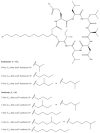Diversity and Activity of Bacteria Cultured from a Cup-The Sponge Calyx nicaeensis
- PMID: 39452848
- PMCID: PMC11509412
- DOI: 10.3390/md22100440
Diversity and Activity of Bacteria Cultured from a Cup-The Sponge Calyx nicaeensis
Abstract
Marine sponges are well-known for hosting rich microbial communities. Sponges are the most prolific source of marine bioactive compounds, which are frequently synthesized by their associated microbiota. Calyx nicaeensis is an endemic Mediterranean sponge with scarce information regarding its (bioactive) secondary metabolites. East Mediterranean specimens of mesophotic C. nicaeensis have never been studied. Moreover, no research has inspected its associated bacteria. Thus, we studied the sponge's bacterial diversity and examined bacterial interspecific interactions in search of a promising antibacterial candidate. Such novel antimicrobial agents are needed since extensive antibiotic use leads to bacterial drug resistance. Bacteria cultivation yielded 90 operational taxonomic units (OTUs). A competition assay enabled the testing of interspecific interactions between the cultured OTUs. The highest-ranked antagonistic bacterium, identified as Paenisporosarcina indica (previously never found in marine or cold habitats), was mass cultured, extracted, and separated using size exclusion and reversed-phase chromatographic methods, guided by antibacterial activity. A pure compound was isolated and identified as 3-oxy-anteiso-C15-fatty acid-lichenysin. Five additional active compounds await final cleaning; however, they are lichenysins and surfactins. These are the first antibacterial compounds identified from either the C. nicaeensis sponge or P. indica bacterium. It also revealed that the genus Bacillus is not an exclusive producer of lichenysin and surfactin.
Keywords: Calyx nicaeensis; Paenisporosarcina indica; antibiotics; biosurfactants; mesophotic; sponges.
Conflict of interest statement
The authors declare no conflicts of interest. The funders had no role in the design of this study; the collection, analyses, or interpretation of data; the writing of the manuscript; or the decision to publish the results.
Figures







Similar articles
-
Abundance and bioactivity of cultured sponge-associated bacteria from the Mediterranean sea.Microb Ecol. 2008 Jan;55(1):94-106. doi: 10.1007/s00248-007-9255-9. Epub 2007 May 13. Microb Ecol. 2008. PMID: 17497228
-
Bacteria From Marine Sponges: A Source of New Drugs.Curr Drug Metab. 2017;18(1):11-15. doi: 10.2174/1389200217666161013090610. Curr Drug Metab. 2017. PMID: 27739371 Review.
-
Competitive interactions between sponge-associated bacteria.FEMS Microbiol Ecol. 2017 Mar 1;93(3). doi: 10.1093/femsec/fix008. FEMS Microbiol Ecol. 2017. PMID: 28115399
-
Antimicrobial potential of metabolites extracted from bacterial symbionts associated with marine sponges in coastal area of Gulf of Mannar Biosphere, India.Lett Appl Microbiol. 2014 Mar;58(3):231-41. doi: 10.1111/lam.12178. Epub 2013 Nov 13. Lett Appl Microbiol. 2014. PMID: 24138171
-
Diversity and biotechnological potential of the sponge-associated microbial consortia.J Ind Microbiol Biotechnol. 2006 Jul;33(7):545-51. doi: 10.1007/s10295-006-0123-2. Epub 2006 Apr 22. J Ind Microbiol Biotechnol. 2006. PMID: 16761166 Review.
References
-
- Simpson T.L. The Epithelia. The Cell Biology of Sponges. Springer; New York, NY, USA: 1984. pp. 42–69.662p
MeSH terms
Substances
Grants and funding
LinkOut - more resources
Full Text Sources
Medical

